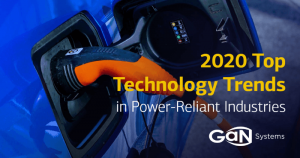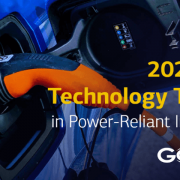The 2020 Top Technology Trends in Power-Reliant Industries
As we move into the next decade of the twenty-first century, it is abundantly clear that we can no longer take power for granted – not its production, distribution, or use. Data and energy are the interlinked and acknowledged power duo that fuels global economic growth. The increasing demand for electricity needs to be understood in terms of the environmental impacts of the fossil fuel and coal used in its production, contrasted with the rapidly evolving economics and technologies around renewable energy that are transforming it into a reliable on-demand resource.

Download the ebook: GaN Systems Looks Ahead to 2020 Game-Changing Technologies Associated With Power Electronics
In the past decade, the global demand for electricity has grown by nearly one-third with an additional 57% increase is expected by 2050. That level of growth calls for revolutionary and not evolutionary action around energy efficiency and clean renewable sources. Otherwise our increasingly technology-driven electric future may end up merely exchanging one source of pollution for another, and drive us deeper into the climate change ditch than we already are.
This need for increasing global energy efficiency and the role that GaN technology plays in delivering that across multiple industries is the focus of our projections into the new decade starting in 2020.
Electric and Autonomous Vehicles
Today, there are 5.1 million electric vehicles on the roads around the world. That is expected to grow to 125 million electric vehicles by 2035. Given the amount of electricity needed as “fuel” for these vehicles, the stage is set for a massive unfavorable hit to the global energy grid unless the issue of the efficiency of energy conversion is aggressively addressed within the vehicles and the infrastructure that supports them.
In 2020, we predict:
- The design of electric vehicles will focus on increased energy efficiency, power density, and reduced weight in order to increase vehicle range and consumer acceptance, while decreasing costs. GaN power semiconductors used in OnBoard Chargers (OBC) and Traction Inverters, along with advances in battery technology and lighter electric motors, will be the driving technologies in this industry transition.
- Autonomous vehicles (which are also electric) will benefit from the increased safety and autonomy provided by higher power, longer range detection capabilities of GaN-enabled LiDAR systems. This will be true for the integration of this technology into Level 2 and Level 3 systems, and then into full Level 5 autonomous systems.
The Rollout of 5G Networks
While the rollout of 5G in 2019 was slower than expected, 2020 should see significant design and deployment advances around the world. By 2025, 70 million micro base stations are expected to be active in 5G networks. With the lower latency and 10x data transmission capacity of 5G versus 4G networks – the greater intelligence that both consumers and businesses are already demanding will be delivered in the next generation of industrial and urban networks. The success of these 5G networks will rely on significantly improved energy efficiency, smaller and more power dense transmitters and receivers, and reliable wireless power transmission.
In 2020, we predict:
- GaN power transistors will be key to the rollout of 5G because of the power density, energy efficiency, and system size requirements for the macro and micro base stations of this new network. Using GaN technology will produce smaller and lighter 5G equipment with up to 50% increase in power density.
- GaN will enable wireless power and data transmission through walls and windows, which means that 5G receivers can be placed outside a building. This kind of configuration results in delivering three times the performance of a receiver placed inside a building.
Renewable Energy Storage 
Renewable energy production has not yet met the mainstream milestone of reliable on-demand availability. That is now set to change on a mass level with technology, social attitudes and policies, and consumer awareness urgently pushing this imperative forward in a race to address climate change and the unreliability of energy grids under pressure.
Solar power is finally poised to move from a ‘boom or bust perception’ to on-demand innovation hero. Residential power generated by rooftop solar in the US is expected to jump to 5.7 gigawatts in 2020, up from 1.8 gigawatts in 2015.
In 2020, we predict:
- GaN power semiconductors will enable the development of smaller, lighter weight, more efficient, and lower cost renewable energy storage systems (ESS) that are a key component to broad adoption of renewable energy in both businesses and residences.
- The movement from lead acid to lithium ion batteries will lead to declining battery costs and the development of smaller, lightweight, energy-dense batteries that will pair with GaN technology-based converters and inverters to lead the revolution in ESS.
- Interest in local micro-grids for both business and residences will grow as individuals look to increase their energy security and leverage a collective of individuals ESSs.
Power Adaptors and Power Chargers
The use of GaN technology in the consumer electronics space has grown with the abundance of smaller, lighter, and higher power adapters and chargers that can now be purchased in the aftermarket.
In 2020, we predict:
- GaN adapters and chargers included inside the box with a laptop, tablet, or mobile phone will become increasingly common, particularly as consumer demand grows for the fast-charging of higher power devices.
- There will be growing consumer demand for a single multi-purpose charger that enables the simultaneous charging of a variety of devices – from a phone (5V), tablet (12V), or laptop (19V). GaN uniquely enables the delivery of this kind of product.
Meeting the Growing Global Energy Challenges of the Next Decade
It is clear that the world can no longer take power for granted. How we choose to invest in and develop new energy efficient technologies, as well as create and implement the policies and social frameworks for deploying them – may well determine the future of our planet. Looking ahead into 2020 and beyond, with products already in the market as well as next generation products in development using GaN technology, it is clear that GaN has become the basic building block of power efficiency that will proliferate through all the power systems of the world.
***
Download our 2020 Trends ebook here to learn how GaN technology will play a role in these trends.


